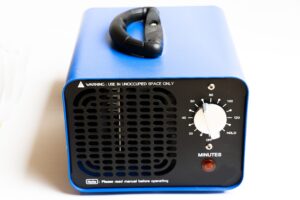
Odor control is a critical part of every restoration and remediation job. While some deodorizing products work by covering up or masking odors, hydroxyl machines and ozone generators are two powerful tools that actually destroy unwanted odors to truly clean the air. While both are effective odor control devices, one may be better suited to your job than the other. So, how do you make the choice? The team at Atex is here to help you understand how these two products compare. We’ve outlined common scenarios to help you select the best option for your next job.
When Time is of the Essence
Recommendation: Ozone generator
Does your project have a tight deadline? Ozone generators work more quickly than hydroxyl machines. Depending on the ozone concertation, they can often deodorize a space in just a fraction of the time that it would take a hydroxyl machine.
When the Job Site is Crowded
Recommendation: Hydroxyl machine
Ozone generators are only designed for use in unoccupied spaces. No people or animals should be in the enclosed space when the machine is running, and at least 30 minutes to an hour should be allowed before re-entry. On the other hand, hydroxyl machines can be used with people and animals present, often making them a preferred choice for times when job sites can’t be temporarily closed or evacuated.
When Working Around Sensitive Materials
Recommendation: Hydroxyl machine, depending on the materials
High concentrations of ozone can wear down fabric, paint, rubber and certain other plastics, especially after extended use. Hydroxyl machines tend to be less harsh on fabrics and materials. If you choose to use an ozone generator, take note of the concentration level and remove any materials that may be impacted before running the machine.
When Concerned About Sanitization
Recommendation: Either
Both ozone generators and hydroxyl machines are not only powerful deodorizers, but highly effective sanitization tools. In addition to removing unwanted odors, both machines can destroy viruses, bacteria, volatile organic compounds (VOCs) and other pathogens.
When You Need to Clean Surfaces and the Air
Recommendation: Ozone generator
While both devices are powerful sanitization tools, hydroxyl machines are effective at attacking airborne pathogens while ozone generators can successfully sanitize both the air and surfaces. As a highly reactive gas, ozone can sanitize otherwise hard-to-reach areas such as uneven or textured surfaces, small crevices and upholstery.
In summary, both commercial ozone generators and hydroxyl machines are strong resources to help remove unwanted odors, destroy bacteria and other pathogens on restoration jobs. This overview is meant to provide a jumping off point to help you understand some of the primary differences between the two and how they compare with one another. There may be additional details to consider, depending on your project’s scope, location or parameters. If you have additional questions about what product would be best for your work, reach out to us. Our team is here to help make sure you have the tools you need to get the job done right.
